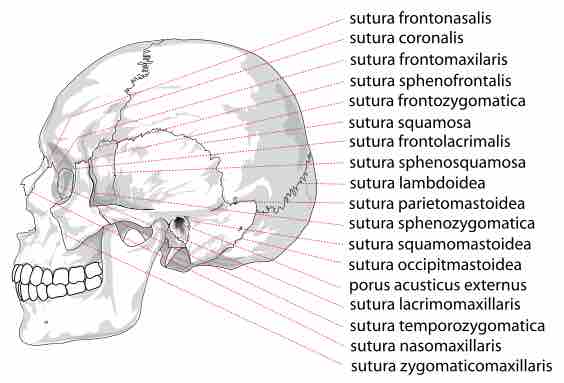A suture is a type of fibrous joint (or synarthrosis) that only occurs in the skull. The bones are bound together by Sharpey’s fibers, a matrix of connective tissue which provide a firm joint.
A small amount of movement is permitted through these sutures that contributes to the compliance and elasticity of the skull. The joint between the mandible and the cranium, known as the temporomandibular joint, forms the only non-sutured joint in the skull. Most sutures are named for the bones that they articulate.
At birth, many of the bones of the skull remain unfused to the soft spots described as fontanelle. The bones fuse relatively rapidly through a process known as craniosynotosis, although the relative positions of the bones can continue to change through life. In old age the cranial sutures may ossify completely, reducing the amount of elasticity present in the skull. As such, the degree of ossification can be a useful tool in determining age postmortem.

Lateral view of a skull showing sutures
The dotted red lines indicate the location of skull sutures.
Sutures primarily visible from the side include:
- Coronal suture: Located between the frontal and parietal bones.
- Lambdoid suture: Located between the parietal, temporal and occipital bones.
- Occipitomastoid suture.
- Parietomastoid suture.
- Sphenofrontal suture.
- Sphenoparietal suture.
- Sphenosquamosal suture.
- Sphenozygomatic suture.
- Squamosal suture: Located between the parietal and the temporal bone.
- Zygomaticotemporal suture.
- Zygomaticofrontal suture.
Sutures primarily visible from front or above include:
- Frontal suture or metopic suture: Located between the two frontal bones, prior to the fusion of the two into a single bone.
- Sagittal suture: Located along the midline, between the parietal bones.
Sutures primarily visible from below or inside include:
- Frontoethmoidal suture.
- Petrosquamous suture.
- Sphenoethmoidal suture.
- Sphenopetrosal suture.